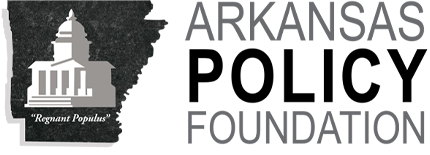Department of Finance and Administration – Five-Year Review (2015-2020)
In late 2015, Governor Asa Hutchinson directed executive agencies under his jurisdiction to assist the Arkansas Policy Foundation “in its evaluation of our state government and in its development of recommendations to streamline stategovernment and to make it more cost effective and citizen accountable.”1
Private Arkansas foundations2 funded the initiative: the Policy Foundation’s Efficiency Project. The Project produced two studies in 2016. One was conducted by PricewaterhouseCoopers (PwC), an international management consulting firm retained by the Foundation at no expense to taxpayers.3 The second relied on Foundation staff andcitizen-volunteers.4 Both identified the state Department of Finance and Administration (DFA) as a key agency.
One recommendation advised a citizen panel like the Reagan-era Grace Commission, also known as the Private Sector Survey on Cost Control.5 In 2017, Gov. Hutchinson announced the Transformation Advisory Board, a panel composed of Lt. Gov. Tim Griffin, state legislators, agency officials, business leaders and academics. The Board’s role was to assist the administration in advancing efficiency and transformation in Arkansas state government. In 2019, the Board’s findings formed the basis for a reorganization plan proposed by Gov. Hutchinson, and enacted by the legislature. Gov. Hutchinson proposed three pillars for transformation: efficiencies in processes, enhanced managerial services, and improved delivery of services. This review does not examine all three areas. Instead, it focuses on several processes at DFA. The Policy Foundation estimates savings from DFA actions at $61.8 million through September 30, 2020.
1 Memorandum to Directors of State Agencies, Offices, and Departments. December 17, 2015. Gov. Hutchinson’s memorandum cited his commitment to “preserving and protecting the financial integrity of our state. Transparency, accountability, and efficiency promote the people’s faith in good government.”
2 These included the Murphy Foundation, the Walton Family Foundation and the George H. Dunklin, Jr. Charitable Foundation.
3 PwC, Efficiency Review of Arkansas State Government, July 2016
4 Policy Foundation, Arkansas Efficiency Project Report, October 2016
5 U.S. President Ronald Reagan established the Commission on June 30, 1982, with Executive Order 12369. The panel, led by businessman J. Peter Grace (1913-1995), presented efficiency recommendations to Congress in 1984.
PwC & DFA: A Focus on Process
Early in the Project, the state Department of Finance and Administration (DFA) was identified as an important agency in terms of efficiency in state government. DFA worked in a collaborative manner with PwC and the Project.Throughout PwC’s 42-page report, there is a focus on process and processes at DFA.
- “DFA has a strong culture of efficiency and lean operations, and management is highly focused on process improvement and cost “
- “While most Offices evaluate their process efficiency, there are opportunities to expand on these measures and evaluate outcomes as “6
- ” … although risk assessments and risk management functions are loosely coordinated across some organizations,these crucial processes are not consolidated across the State.”7
- “Multiple interviewees mention numerous opportunities within the State to modify and automate the customer-facing processes managed by the Revenue Office; these opportunities included automation, self-service, and digital tools, which can be used to optimize processes involved in driver and vehicle services, tax lien registration, and taxpayer communication, areas in which automation is still not widespread.”8
- “(T)here are opportunities within the State to modify and automate the customer-facing processes managed bythe Revenue The areas where automation, self-service, and digital tools can be used to optimize processes initially are driver and vehicle services, tax lien registration, and taxpayer communication.”9
- “Process improvement offers the State tremendous opportunities to cut costs, and can improve efficiencies …”10
PwC Recommendations to DFA with Savings Estimate
PwC’s report included nine major recommendations to DFA:11
6 PwC, Efficiency Review of Arkansas State Government, July 2016, pp. 6
7 Ibid., p. 7
8 Ibid., p. 8
9 Ibid., p. 24
10 Ibid., p. 25
11 PwC identified four inputs before making recommendations: Interviews – To determine the current state of DFA and State operations , the team interviewed 21 DFA management personnel and other State officials. After most interviews were completed, the assessment team conducted a workshop with DFA members todiscuss the findings to date and brainstorm further opportunities for efficiency improvements. Surveys – An anonymous survey solicited DFA management-level feedback on operations and
- Develop a statewide strategic framework to align budgets and operations;
- Develop a centralized risk management function to appropriately identify and manage risk, especially procurement risk;
- Re-evaluate organizational alignment and functions;
- Transform the talent of the State through a human resources strategic plan;
- Modernize the State’s compensation and benefits programs;
- Conduct deep process analysis to optimize accounting and tax assessment/collection processes necessary to execute the State’s mission;
- Automate processes to allow the State and customers to use self-service options;
- Enhance Information Systems governance and develop a centralized shared services and infrastructure architecture plan;
- Enhance innovation and collaboration, focused on the use of digital technology to increase efficiency.
This review focuses on tax assessment/collection processes recommendations. PwC noted “tax assessment andcollection processes have resulted in significant backlog of taxes for the State. The State has approximately $1.434B in uncollected tax debts, of which $321M has been deemed collectable by the State.”12
In July 2017, DFA reported to the Transformation Advisory Board that it was acting in response to each recommendation. The most significant from a revenue perspective was DFA’s response to PwC’s recommendation13“to optimize accounting and tax assessment/collection processes …” DFA told the Board:
“The Department’s Office of Field Audit began an afterhours phone line pilot program to facilitate collections … As part of DFA’s Strategic Plan the Department plans to make the extended hours service permanent.”
processes, as well as opportunities for improvement for both the State and DFA. The survey was open for seven days, and all 40 DFA management-level employees to whom the survey was sent responded. Documentation Review – The team reviewed documentation provided by DFA and publicly available information to aid in the analysis of the agency’s activities and identify opportunities for operational efficiency. Leading Practice Research – Based on the inputreceived from interviews and surveys, the assessment team conducted leading practice research, as there is a tremendous amount to be learned throughbenchmarking and comparison across states. The team reviewed similar challenges and programs in: Alabama, Arizona, Florida, Georgia, Illinois, Kansas, Maine, Michigan, Mississippi, New York, North Carolina, Oklahoma, Tennessee, Texas, Virginia, and Washington.”
12 PwC, p. 22. These are not “Under Protest,” a separate category.
13 The second Efficiency Project report also made a recommendation in this area (see below for additional background).
PwC’s recommendation in this area focused on process:
“Conduct deep process analysis to optimize accounting and tax assessment/collection processes necessary to execute the State’s mission.”
DFA’s second shift reduced receivables by $44.9 million between February 2017 and September 2020, according to the attached one-page ‘Collection Recovery’ report.
Savings Estimate: $44.9 Million
Foundation Recommendations to DFA with Savings Estimate
The second Project study conducted by Foundation staff and citizen-volunteers also focused on processes. The report made 60 recommendations including several applicable to processes at DFA.
The “strong culture of efficiency” noted by PwC is evident in DFA’s competent and highly capable response to this second set of recommendations in the ensuing five-year period.
Recommendation No. 1 (Mission Statements): “Each agency should include the word efficiency in their mission statement and post it online in an easily accessible format.” DFA amended their Vision Statement: “Bring appropriate, innovative, and efficient operating practices to Arkansas state government.”
Recommendation No. 3 (Agency Strategic Plans): “Only five state agencies post a strategic plan. This culture runs counter to a Government Finance Officers Association recommendation that ‘all government entities use some form of strategic planning to provide a long-term perspective for service delivery and budgeting, thus establishing logical linksbetween authorized spending and broad organizational goals.’ Each agency should have a strategic plan andpost it online so it is accessible to citizens.” DFA created a Strategic Plan.
Recommendation No. 4 (Efficiency Section): “Each plan should include a section explaining how the agency will advance efficiency.” DFA’s Strategic Plan explained, “Efficiencies and Responsiveness: Leverage State Resources To deliver Results For Arkansas Taxpayers.”
Recommendation No. 6 (Performance Measures): “Agency measures should be quantifiable.” DFA’s response included the following measures: “Measurable Objective 3: Maximize the collection of state revenues. Strategy 1: Establish an after-hours collections phone number. Continue successful after-hours collection pilot program by the Office of Field Audit. Hire fulltime staff. Inform public of extended hours to call. Track payment plans established by after-traditional-hours’ contacts. Consider expanding to other areas of collection.”
Recommendation No. 36 established a five percent (5%) reduction goal in terms of outstanding accounts receivable.14
Policymakers and state analysts have devoted insufficient attention to this final issue. The size of the uncollected tax debts described in 2016 by PwC-$1.434 billion-is large enough to warrant its own study. DFA’ssuccess at identifying the collectable portion and revising processes to address the problem have goneunrecognized, and should be acknowledged. The
14 A Policy Foundation Freedom Of Information (FOIA) request in early 2015 found no written procedures in this area.
historical record is scant. An Arkansas Legislative Audit site15 search revealed a 2007 report16 that notes, “Accountsreceivable as recorded by the Agency totaled
$580,955,934 at June 30, 2007, and are summarized at Schedule 2.”17 As noted
earlier, PwC, citing DFA in 2016, reported, “$321M has been deemed collectable by the State.” Thus, a five percentreduction would be equivalent to $16,050,000. The second shift Collection Recovery clearly exceeded this goal, reducing receivables by $44.9 million. DFA achieved this goal by taking several actions:
- Establish an after-hours collections phone number;
- Identify and implement new and existing tools to enhance revenue collections;
- Increase intra-agency collaboration on revenue
DFA has taken other proactive steps to reduce receivables. In March 2018, the agency “began a Collection Garnishment Section.”18 Recoveries totaled $16.9 million from March 2018 through September 2020.
DFA reports “Changes to Collecting Efforts” include the following:
- “Focus on most meaningful and collectable debt. For example, focusing on recent debt rather than oldest debt.”
- “The implementation and growth in the use of flexible collection efforts. Examples include payment plans, adjustable due dates and multiple payment options.”
Savings Estimate: $16.9 Million
Conclusion
Five years ago, the Efficiency Project identified DFA as a key agency to advance efficiency in Arkansas state government. PwC and the Policy Foundation made recommendations in two reports.
Gov. Hutchinson proposed three pillars for transformation: efficiencies in processes, enhanced managerial services, and improved delivery of services. The reorganization created the state Department of Transformation and Shared Services to oversee these efforts. The first pillar-efficiencies in processes–has received little attention as they apply to DFA. In essence, it is early in the game; the first quarter.
16 Arkansas Legislative Audit, “Department of Finance and Administration Revenue Division — Individual Income Tax Section, Annual Financial Report, June 30, 2007.”
17 A footnote to the 2007 report reports, “The Agency indicated that a significant portion of the accounts receivable was due to the delinquent tax return program, in which returns have been filed by the Delinquent Tax Branch for those individuals who filed a federal income tax return with an Arkansas address, but did not file an Arkansas tax return. As these accounts are worked by various sections of the Revenue Division, the actual amounts that are collectible, if any, are determined.”
18 DFA memorandum (December 29, 2020) “Office of Field Audit Collections Section.”
A strong, preexisting DFA culture has applied Project recommendations to significantly improve several processes.
Total savings from DFA actions to improve these processes is estimated at $61.8 million through September 30, 2020.
The Project made recommendations about improving processes in other policy areas. The Foundation will document these savings as data is made available.
Limitations
The estimate does not include any forecast of future activity.
This review only examines DFA’s response to Project recommendations in one policy area. It does not review otherDFA processes or similar process initiatives at other state agencies.
Nothing in this report should be construed as supporting or opposing any legislation.









